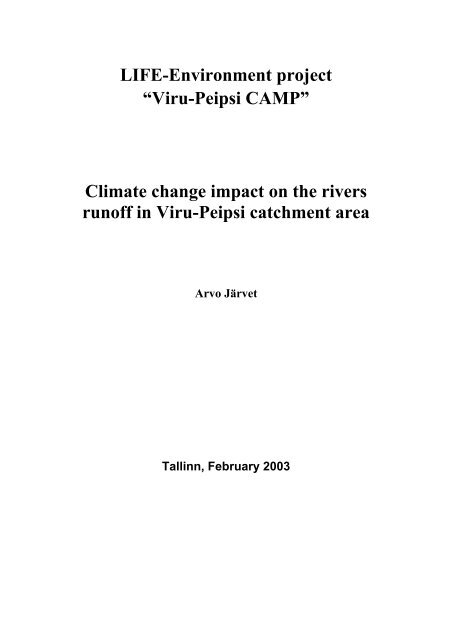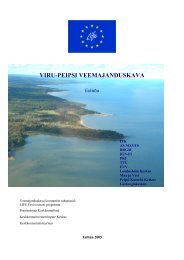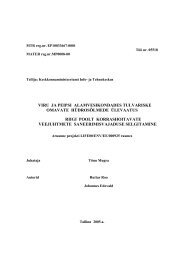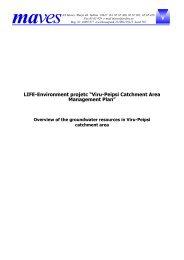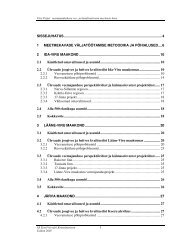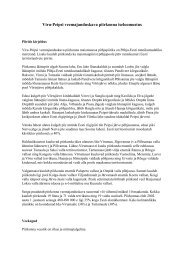open file - Viru Peipsi
open file - Viru Peipsi
open file - Viru Peipsi
You also want an ePaper? Increase the reach of your titles
YUMPU automatically turns print PDFs into web optimized ePapers that Google loves.
LIFE-Environment project<br />
“<strong>Viru</strong>-<strong>Peipsi</strong> CAMP”<br />
Climate change impact on the rivers<br />
runoff in <strong>Viru</strong>-<strong>Peipsi</strong> catchment area<br />
Arvo Järvet<br />
Tallinn, February 2003
Introduction<br />
Global climate change due to the increase of greenhouse gas concentration in<br />
the atmosphere is a powerful factor expressing the anthropogenic stress on<br />
natural environment. The highest warming is expected to take place in high<br />
latitudes. Water resources are very sensitive to climate change and studies on<br />
this topic have been carried out for many regions in Europe. Possible climate<br />
warming can cause significant changes in hydrological regime and water<br />
resources, including the rivers runoff.<br />
Understanding the sensitivity of water resources is the first and one of most<br />
important steps in the climate change impact assessment. Impact research<br />
needs to address these problems include development of 1) a more physically<br />
based understanding of hydrological processes and their interactions, 2)<br />
hydrological parameter measurement and estimation techniques for<br />
application over a range of spatial and temporal scales, and 3) modular<br />
modelling tools to provide a framework to facilitate water management<br />
research (Leavesley, 1994).<br />
Water balance model WatBal<br />
An assessment of climate change impacts on water resources is a complex<br />
process. Different macro-scale and landscape-scale hydrologic models are used<br />
for this purpose. These models usually require detailed climatic and other input<br />
data on the site or area of interest. Examples of these models include also<br />
hydrological catchment models, by which can be simulate changes in local<br />
hydrologic regime of rivers under climate change scenarios.<br />
Hydrological models provide a framework in which to conceptualize and<br />
investigate the relationships between climate and water resources. Results of<br />
this study could also be necessary information in general water resources<br />
planning; however they are seldom used for it at present. Possible climate<br />
warming can cause significant changes in hydrological regime and water<br />
resources. The key problem is, how will change precipitation amounts and snow<br />
cover regime. Rivers runoff, groundwater level and recharge, land drainage and<br />
water resources management directly depend upon them.<br />
To investigate the influence of climate change on river runoff, the point model<br />
WatBal (Yates, 1994) was applied. This model, realised as a MS Excel macro, is<br />
considered to be a suitable tool for assessments of climate change impact on<br />
river runoff (Yates, Strzepek, 1994). It was validated for Estonia and used within<br />
the implementation of climate change impact research programmes (Järvet et<br />
al, 2000). General calibration and validation of the WatBal model for Estonian<br />
conditions was made. Different decades within the baseline period (1961–1990)<br />
were used for calibration and validation of the model.
Climate change scenarios used in modelling of river runoff<br />
MAGICC model and SCENGEN program were applied for climate<br />
change scenario generation in this study. Three alternative greenhouse gas<br />
emission scenarios developed by IPCC (IS92a, IS92c, IS92e) are combined<br />
with results of two general circulation model (GCM) experiences (HadCM2,<br />
ECHAM3TR). As a result, six climate change scenarios up to the year 2100<br />
are prepared for modelling climate change impact on river runoff. The<br />
following abbreviations are used:<br />
HAD - HadCM2 model,<br />
HAM - ECHAM3TR model,<br />
MID - IPCC medium emission scenario (IS92a),<br />
MIN - IPCC minimum emission scenario (IS92c),<br />
MAX - IPCC maximum emission scenario (IS92e).<br />
GCM results are available for 5x5 degree cells. Therefore, the territory of<br />
Estonia is covered by two cells. The border between West and East Estonia<br />
is, in this case, 25°E. The studied watersheds, presented in Table 1, are<br />
located in eastern sector.<br />
In general, results of the both GCMs are quite similar. They project higher<br />
increase of air temperature during the winter half-year (October–March) and<br />
lower increase in the period April–September. Although, the German model<br />
(ECHAM3TR) developed by Max Planck Institute for Meteorology in Hamburg<br />
expects higher warming than the British (Hadley Centre) one – HadCM2. The<br />
increase of air temperature in East Estonia should be higher than in West<br />
Estonia, especially in winter.<br />
Modelling results<br />
Using the WatBal model, changes in river runoff in case of the six climate<br />
scenarios were calculated for all 14 studied river basins. The modelled<br />
changes in annual mean runoff in different basins and scenarios range from<br />
+5% (River Kunda) to +72% (Emajõgi River in station Tartu). Changes in<br />
annual runoff are presented in Table2. The HadCM2 model shows less<br />
increase of runoff while the ECHAM3TR model indicates more increase. The<br />
emission scenarios have rather linear differences. The lowest increase in river<br />
runoff is projected by the HADMIN scenario, the highest one – by HAMMAX.<br />
The highest increase in annual runoff is calculated for Emajõgi River<br />
(catchment area 7840 km 2 ), and also for small river basin Kääpa in not far<br />
from Lake <strong>Peipsi</strong>. In general, an increase of annual runoff by 20–30 per cent<br />
(HADMID) or by 40–50 per cent (HAMMID) are modelled for the year 2100.<br />
These changes can be consider as significant.
Table1. Changes in annual runoff according to different climate change<br />
scenarios (percentages)<br />
River Station HADMID HADMIN HADMAX HAMMID HAMMIN HAMMAX<br />
Ahja Ahja 26 13 31 39 21 51<br />
Ahja Koorvere 36 24 40 48 32 59<br />
Avijo Mulgi 24 11 30 41 21 54<br />
Emajõgi Tartu 46 33 51 60 42 72<br />
Kääpa Kääpa 30 16 36 48 27 61<br />
Kunda Sämi 15 5 19 27 13 36<br />
Piiga009 Piigaste 18 7 22 31 15 41<br />
Põltsamaa Pajusi 23 11 28 37 19 46<br />
Pungerja Roostoja 22 10 28 38 20 49<br />
Purtse Lüganuse 18 6 23 33 15 43<br />
Tagajõgi Tudulinna 22 9 28 40 20 52<br />
Võhandu Räpina 26 14 31 40 22 51<br />
Võhandu Himmiste 29 16 33 42 24 54<br />
Not only total increase of annual runoff is important but also its seasonal<br />
distribution. In most of the impact studies, the consequences of a greenhouse<br />
effect for runoff are analysed and discussed, while seasonal patterns of runoff<br />
have received less attention, especially concerning their regularity. Modelling<br />
results demonstrate a possibility of enormous changes in seasonal runoff on<br />
the eastern part of Estonia. The results below (Figures 1–3) illustrate<br />
geographical differences in the sensitivity of runoff to climate change.<br />
Maximum runoff is more sensitive than minimum runoff.<br />
For the studied rivers, the modelled annual curve of runoff is similar to<br />
baseline. A decrease of modelled runoff in spring and its increase in autumn<br />
is typical to all river basins, especially to the rivers of North-Estonia.<br />
Figures 1–3 demonstrate a variety of runoff responses to climate change in<br />
different landscape regions. Observed curves of monthly runoff for the<br />
baseline period (1961–1990) and modelled curves for the year 2100 are<br />
presented. In addition to the medium climate change scenarios HADMID and<br />
HAMMID, HADMIN as the lowest change scenario and HAMMAX as the<br />
highest one are demonstrated.<br />
Võhandu River basin is located in South-East Estonia in the region of the<br />
most continental climate. There, changes in annual course of runoff will be the<br />
less remarkable (Fig. 1). The runoff maximum in spring will move by a month<br />
earlier, but will not decrease. ECHAM3TR model indicates even an increase<br />
of the maximum.
mm/day<br />
1.60<br />
1.40<br />
1.20<br />
1.00<br />
0.80<br />
0.60<br />
0.40<br />
0.20<br />
0.00<br />
Jan Feb Mar Apr May Jun Jul Aug Sep Oct Nov Dec Jan<br />
Baseline<br />
HADMID<br />
HADMIN<br />
HAMMID<br />
HAMMAX<br />
Fig. 1. Changes in monthly runoff in Võhandu River (station Räpina).<br />
Modelled data for Emajõgi River basin (Fig. 2) have the highest increase in<br />
runoff. But the predicted seasonal variations of discharge are quite similar to<br />
the previous example. The increase in winter runoff and its maximum in<br />
March in case of Emajõgi River basin is higher. It is caused by a fact that this<br />
river has the largest catchment area and runoff is naturally regulated by Lake<br />
Võrtsjärv.<br />
1.60<br />
1.40<br />
mm/day<br />
1.20<br />
1.00<br />
0.80<br />
0.60<br />
0.40<br />
0.20<br />
0.00<br />
Jan Feb Mar Apr May Jun Jul Aug Sep Oct Nov Dec Jan<br />
Baseline<br />
HADMID<br />
HADMIN<br />
HAMMID<br />
HAMMAX<br />
Fig. 2. Changes in monthly runoff in Emajõgi River basin (station Tartu).<br />
The Kunda River basin is typical to a limestone plateau and a karst region in<br />
North Estonia. It has a great groundwater inflow that makes slower the runoff<br />
decrease after spring maximum, and higher the level of runoff minimum in<br />
summer. Both the maximum in spring and minimum in summer will be shifted<br />
earlier in case of climate change (Fig. 3). The increase of runoff in autumn will<br />
be significant in Kunda River basin.
2.50<br />
mm/day<br />
2.00<br />
1.50<br />
1.00<br />
0.50<br />
Baseline<br />
HADMID<br />
HADMIN<br />
HAMMID<br />
HAMMAX<br />
0.00<br />
Jan Feb Mar Apr May Jun Jul Aug Sep Oct Nov Dec Jan<br />
Fig. 3. Changes in monthly runoff in Kunda River (station Sämi).<br />
Shift of spring runoff maximum earlier will result in longer duration of summer<br />
low water period and in decrease of total runoff during vegetation period (from<br />
April to September) in many river basins of Estonia. The area of increased<br />
runoff in summer is located in South-East Estonia and of decreased values in<br />
the rest of the territory. The most remarkable decrease is modelled for rivers<br />
with relatively high spring maximum runoff and not higher natural regulation<br />
(River Tagajõgi and River Pedja).<br />
There are big differences in the ratio of minimum and maximum runoff<br />
between the river basins, although the difference between modelled and<br />
observed monthly minimum runoff has a low regional variation and was<br />
positive. It indicates that change in minimum runoff is not projected in case of<br />
climate warming, but the decrease of maximum runoff may be significant. The<br />
ratio between maximum and minimum monthly runoff will decrease very<br />
much. Therefore, seasonal fluctuations of runoff will remarkably diminish due<br />
to climate change and natural regulation of runoff will be increased (Table 2).<br />
Table 2. Changes of coefficient of annual runoff natural regulation<br />
River–station Observe HADMID HADMIN HADMAX<br />
d<br />
Ahja–Ahja 0.87 0.90 0.89 0.90<br />
Ahja–Koorvere 0.88 0.91 0.90 0.91<br />
Avijōgi–Mulgi 0.75 0.79 0.78 0.79<br />
Emajōgi–Tartu 0.90 0.91 0.91 0.91<br />
Kunda–Sämi 0.85 0.89 0.88 0.88<br />
Kääpa–Kääpa 0.78 0.83 0.81 0.82<br />
Pedja–Tõrve 0.78 0.81 0.80 0.81<br />
Piigaste–Piigaste 0.82 0.85 0.83 0.86<br />
Pōltsamaa–Pajusi 0.85 0.88 0.88 0.87<br />
Pungerja–Roostoja 0.75 0.80 0.78 0.80<br />
Purtse–Lüganuse 0.77 0.81 0.79 0.81
Tagajõgi– 0.69 0.74 0.71 0.74<br />
Tudulinna<br />
Vōhandu–Räpina 0.88 0.89 0.89 0.88<br />
Vōhandu–Himmiste 0.87 0.89 0.90 0.87<br />
Impact on the water management<br />
The rivers runoff maximum in spring diminishes, and starts a month earlier (in<br />
March instead of April). However, the autumn and winter runoffs substantially<br />
increase and therefore the difference between maximum and minimum runoff<br />
will be decreased. Low flow characteristics of rivers are important for different<br />
water-based activities and is required for such water resource management<br />
issues as water supply, water quality and quantity estimates. If minimum<br />
runoff will be increased, that it is positive factor for rivers water management,<br />
especially for wastewater discharge and recreational use of rivers (Table 3).<br />
Table 3. Comparison of the climate change impacts on the different<br />
water regime and water resources elements<br />
Water Resources Positive Results<br />
Element<br />
Changes in Rivers Runoff<br />
Increase winter Favourable ecological<br />
minimum runoff condition, diminishing<br />
Decrease maximum<br />
runoff in spring<br />
Longer summer<br />
minimum runoff period<br />
Increase maximum<br />
runoff in autumn<br />
Changes in<br />
Agricultural Runoff<br />
floods in spring<br />
Diminishing floods in<br />
spring<br />
Better ecological<br />
conditions in drainaged<br />
forest areas<br />
Favourable ecological<br />
condition for water bodies,<br />
Smaller peak flow in<br />
spring, diminish of<br />
pollution load and washoff<br />
of fertilizers<br />
Negative Results<br />
Longer summer<br />
minimum runoff period,<br />
diminishing water<br />
capacity in soil<br />
Unfavourable ecological<br />
condition in rivers,<br />
increase high plant and<br />
algal productivity in<br />
lakes and water<br />
reservoirs, increase the<br />
evaporation rate on the<br />
surface of water bodies<br />
More floods in autumn<br />
and inadequate<br />
drainage of agricultural<br />
land<br />
Difficulties in the harvest<br />
period in autumn
Changes in Water<br />
Level and Storage in<br />
Lakes<br />
Water level Decrease the flooded<br />
areas surround of lakes<br />
during the higher water<br />
period<br />
Storage of lakes Increase of total and<br />
active storage of lakes<br />
during winter period<br />
Possible decrease the<br />
level in the end of<br />
summer under the<br />
optimal level<br />
Conclusions<br />
In general, all climate change scenarios for Estonia forecast mild winters, a<br />
decrease in snow cover and an increase in the duration of dry periods in mid–<br />
summer. The predicted global warming will cause more changes in the water<br />
balance elements in the cold period than in the warm season. Modelled<br />
annual runoff and its seasonal variability in study area are not very sensitive<br />
to climate change. The main results of the study are following:<br />
• Periodical fluctuations of water level and river runoff. Long time<br />
series of annual precipitation has a significant periodicity of 25–35<br />
years in Estonia during more than a century. It causes long-term<br />
fluctuations in hydrological regime and alternation of wet and dry<br />
periods also in the future.<br />
• Increase in annual runoff. Due to the climate change, annual runoff<br />
will increase by 20–40 % in the average, for the year 2100, but<br />
modelled river runoff show a great spatial variation.<br />
• Significant increase in winter runoff. During mild winters, duration of<br />
snow and ice cover should decrease, winter weather should be<br />
changed more unstable, freezing and melting periods should<br />
alternate.<br />
• Decrease of spring runoff maximum and its shift earlier. Mild winters<br />
cause faster melting of snow and earlier beginning of spring<br />
hydrological season. Frequent melting periods in winter prevent big<br />
accumulation of snow. The mean maximum runoff should move<br />
from April to March.<br />
• Increase of river runoff in autumn. This is directly caused by<br />
significant increase of autumn precipitation predicted by both of the<br />
GCMs. In East-Estonia autumn maximum runoff would not exceed<br />
maximum runoff in spring.<br />
• Lengthening of the period of minimum runoff in summer. Due to<br />
faster melting of snow, decreasing and moving earlier of runoff<br />
maximum in spring, dry period should begin earlier. Minimum runoff<br />
period when rivers receive the majority of water from groundwater,
will start not in June but in May. It could cause a severe water<br />
deficit in some small river basins in catchment area of River Pedja.<br />
• Maximum runoff to be more sensitive than minimum runoff. Spring<br />
floods have decreased, because of the lack of snow in the end of<br />
winter period.<br />
• All these modelled changes can be considered to be inside the<br />
observed natural variation of rivers runoff during the baseline period<br />
in 1961–1990.<br />
• Changes of hydrological conditions should be translated into<br />
changes in ecology of water-bodies also, because a number of<br />
ecological processes dependent from hydrological conditions. It can<br />
be concluded that positive impacts of climate warming on ecological<br />
state of water-bodies are prevailing in study area.<br />
• If minimum runoff will increase then it will act as a positive factor for<br />
water management of rivers, especially for wastewater discharge,<br />
navigation and recreational use.<br />
References<br />
Järvet, A., Jaagus, J., Roosaare, J., Tamm, T. and Vallner, L. 2000. Impact of<br />
Climate Change on Water Balance Elements in Estonia. – Estonia,<br />
Geographical Studies 8 (Eds. Tiia Kaare and Jaan-Mati Punning). Estonian<br />
Academy Publishers, Tallinn, pp. 35–55.<br />
Leavesley, G.H. 1994. Modeling the effects of climate change on water<br />
resources - a review. - Climate Change 28: 159-177.<br />
Yates, D., 1997. Approaches to continental scale runoff for integrated<br />
assessment models. J. Hydrol., 201, 289–310.<br />
Yates, D. & Strzepek, K., 1994. Comparison of models for climate change<br />
assessment of river basin runoff. IIASA WP-94-45.


